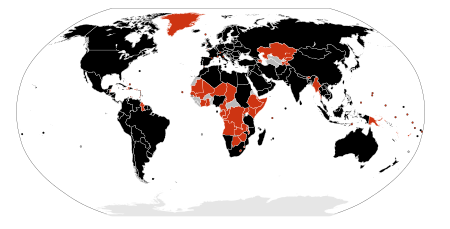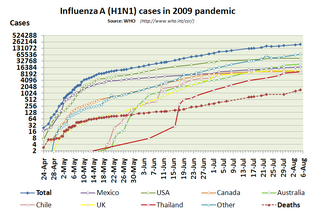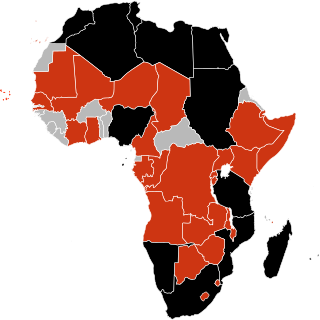Chart
| WHO figures chart of progression [2] |
 |
This is a table containing the figures from the WHO Influenza A Situation Updates issued in April 2009 roughly once a day. [1] Where more than one update was issued in a day, the figures are from the last update that day. The table can by sorted by country, date of first confirmed case or date of first confirmed case by continent.
This presentation of the data in these and other tables shows the progression, peaks, and, eventually, decline of the epidemic in each country and continent.
Previous month | Next month
| WHO figures chart of progression [2] |
 |
| By date | By cont. | Country | 24 | 26 | 27 | 28 | 29 | 30 |
|---|---|---|---|---|---|---|---|---|
| 0 | 0 | World | 25 | 38 | 73 | 105 | 148 | 257 |
| 0 | 0 | Days to double (approx) | 2 | 2 | 2 | 2 | ||
| 0 | 0 | Countries | 2 | 2 | 4 | 7 | 9 | 11 |
| 1 | 1.01 | 18 | 18 | 26 | 26 | 26 | 97 | |
| 2 | 1.02 | 7 | 20 | 40 | 64 | 91 | 109 | |
| 3 | 1.03 | 6 | 6 | 13 | 19 | |||
| 4 | 2.01 | 1 | 2 | 4 | 13 | |||
| 7 | 2.02 | 2 | 5 | 8 | ||||
| 9 | 2.03 | 1 | 1 | |||||
| 8 | 2.04 | 3 | 3 | |||||
| 10 | 2.05 | 1 | ||||||
| 11 | 2.06 | 1 | ||||||
| 6 | 3.01 | 2 | 2 | 2 | ||||
| 5 | 4.01 | 3 | 3 | 3 | ||||
| By date | By cont. | Country | 27 | 30 |
|---|---|---|---|---|
| 0 | 0 | World | 6 | 8 |
| 0 | 0 | Countries | 1 | 2 |
| 1 | 1.01 | 6 | 7 | |
| 2 | 1.02 | 1 | ||



An influenza pandemic is an epidemic of an influenza virus that spreads across a large region and infects a large proportion of the population. There have been five in the last 140 years, with the 1918 Spanish flu pandemic being the most severe; this pandemic is estimated to have been responsible for the deaths of 50–100 million people. The most recent, the 2009 swine flu pandemic, resulted in under a million deaths and is considered relatively mild. These pandemics occur irregularly.

The global spread of H5N1 influenza in birds is considered a significant pandemic threat. While other H5N1 influenza strains are known, they are significantly different on a genetic level from a recent, highly pathogenic, emergent strain of H5N1, which was able to achieve hitherto unprecedented global spread in 2008. The H5N1 strain is a fast-mutating, highly pathogenic avian influenza virus (HPAI) found in multiple bird species. It is both epizootic and panzootic. Unless otherwise indicated, "H5N1" in this timeline refers to the recent highly pathogenic strain of H5N1.

The global spread of H5N1 in birds is considered a significant pandemic threat.
The 2009 flu pandemic in the United States was caused by a novel strain of the Influenza A/H1N1 virus, commonly referred to as "swine flu", that was first detected on 15 April 2009. While the 2009 H1N1 virus strain was commonly referred to as "swine flu", there is no evidence that it is endemic to pigs or of transmission from pigs to people; instead, the virus spreads from person to person. On June 6, the World Health Organization and the Obama administration declared a public health emergency.

This article covers the chronology of the 2009 novel influenza A (H1N1) pandemic. Flag icons denote the first announcements of confirmed cases by the respective nation-states, their first deaths, and relevant sessions and announcements of the World Health Organization (WHO), the European Union , and the U.S. Centers for Disease Control (CDC).

This article deals with the status and efforts regarding the 2009 swine flu pandemic by country and continent/region.

The pandemic H1N1/09 virus is a swine origin influenza A virus subtype H1N1 strain that was responsible for the 2009 swine flu pandemic. This strain is often called swine flu by the public media. For other names, see the Nomenclature section below.
This page summarises the figures from the WHO Influenza A Situation Updates issued roughly once every other day, and since 6 July from ECDC. For each country or territory, the table lists the number of confirmed cases of swine flu on the first reported day each month, and the latest figure. The number of countries affected is shown, and the number of days it has taken for the number of cases to double. The table can be sorted by country, date of first confirmed case or date of first confirmed case by continent.

The 2009 flu pandemic hit Africa two months later than other continents with the first case reported in Egypt on June 2, 2009. As of December 1, 30 countries in Africa had reported cases and 7 countries in Africa had reported a total of 108 deaths. It was the least affected continent.

The 2009 flu outbreak in Malaysia is part of a larger flu pandemic involving a new type of influenza A virus subtype H1N1 virus. As of 11 August 2009, the country has over 2,253 cases, beginning with "imported" cases from affected countries, including the United States and Australia from 15 May 2009 onwards, and the first identified local transmission on 17 June 2009. From 12 August, the Malaysian Health Ministry said that it had discontinue officially updating the total number of H1N1 cases within Malaysia in line with guidelines issued by the World Health Organization. As of 21 August 2009 the unofficial number of cases reported in the media is 5,876 so far. The first death related to the A(H1N1) virus was reported on 23 July 2009 and so far there have been 78 deaths reported. On 6 July 2009 Malaysia announced that it was shifting from containment to mitigation to tackle the spread of the virus. The federal government has declared a national health emergency in Malaysia because of the A(H1N1) outbreak and is considering imposing a health curfew similar to the week-long shutdown of non-essential services and industries in Mexico.
This is a table containing the figures from the WHO Influenza A Situation Updates issued in May 2009 roughly once a day. Where more than one update was issued in a day, the corresponding figures are from the last update that day. The table can by sorted by country, date of first confirmed case or date of first confirmed case by continent.
This is a table containing the figures from the WHO Influenza A Situation Updates issued in June 2009 roughly three times a week. The table can by sorted by country, date of first confirmed case or date of first confirmed case by continent.
This is a table containing the figures from the WHO Influenza A Situation Updates issued in July 2009 roughly three times a week, and, since 15 July, figures from ECDC. The table can by sorted by country, date of first confirmed case or date of first confirmed case by continent.
This is a table containing the figures from the ECDC Influenza A Situation Updates issued in August 2009 roughly three times a week. From 10 August, ECDC only published deaths totals outside its area. The table can by sorted by country, date of first confirmed case or date of first confirmed case by continent.
This is a table containing the figures from the ECDC Influenza A Situation Updates issued in September 2009 roughly three times a week. From 10 August, ECDC only published deaths totals outside its area, and so the world cases table has not been maintained. The table can be sorted by country, date of first confirmed case or date of first confirmed case by continent.
This is a table containing the figures from the ECDC Influenza A Situation Updates issued in October 2009 roughly three times a week. From 30 September, ECDC only published deaths totals, and so the world cases table has not been maintained. The table can be sorted by country, date of first confirmed case or date of first confirmed case by continent.
This is a table containing the figures from the ECDC Influenza A Situation Updates issued in November 2009 roughly three times a week. From 30 September, ECDC only published deaths totals, and so the world cases table has not been maintained. The table can be sorted by country, date of first confirmed case or date of first confirmed case by continent.
This is a table containing the figures from the ECDC Influenza A Situation Updates issued in December 2009 roughly three times a week. From 30 September, ECDC only published deaths totals, and so the world cases table has not been maintained. The table can be sorted by country, date of first confirmed case or date of first confirmed case by continent.

This page contains the number of cases of coronavirus disease 2019 (COVID-19) reported by each country and territory to the World Health Organization and published in the latter's daily 'situation reports'. On 17 August 2020, WHO moved to provide a CSV file of daily figures.

The COVID-19 pandemic was confirmed to have reached Ethiopia on 13 March 2020. The national government led Prime Minister Abiy Ahmed declared a five-month state of emergency in April 2020 but has allowed economic activities to continue during the public health crisis.